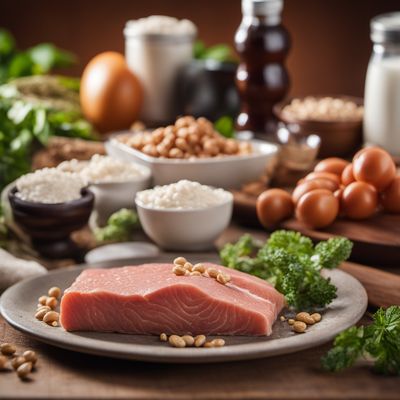
Ingredient
Carbohydrate-electrolyte solutions for sports people
The Power of Sports Nutrition: Carbohydrate-Electrolyte Solutions
Carbohydrate-electrolyte solutions are specially formulated beverages that combine carbohydrates and electrolytes to optimize hydration and energy levels during exercise. These solutions typically contain a mix of sugars, such as glucose and fructose, along with electrolytes like sodium, potassium, and magnesium. They are designed to replenish fluids, maintain electrolyte balance, and provide a quick source of energy for athletes and active individuals. The taste of these solutions can vary depending on the brand and flavor, ranging from mildly sweet to tangy or citrusy. They are usually clear or lightly colored, with a thin and refreshing texture.
Origins and history
Carbohydrate-electrolyte solutions were first developed in the late 1960s as a way to enhance athletic performance and prevent dehydration during prolonged exercise. They gained popularity in the sports community due to their ability to provide a convenient and easily digestible source of energy and hydration. Over the years, extensive research has been conducted to optimize the composition of these solutions, resulting in various formulations tailored to specific sports and activities. Today, carbohydrate-electrolyte solutions are widely used by athletes, ranging from professional sports teams to recreational enthusiasts, to improve endurance, prevent muscle cramps, and enhance overall performance.
Nutritional information
Carbohydrate-electrolyte solutions are low in calories and provide a quick source of energy. They typically contain a mix of carbohydrates, such as glucose, fructose, and maltodextrin, which are easily absorbed by the body to fuel muscles. Additionally, these solutions contain electrolytes like sodium, potassium, and magnesium, which help maintain fluid balance and support proper muscle function.
Allergens
Carbohydrate-electrolyte solutions may contain allergens such as artificial sweeteners, flavorings, or colorings. Individuals with specific allergies or sensitivities should carefully read the ingredient labels to ensure they are suitable for consumption.
How to select
When selecting carbohydrate-electrolyte solutions, it is important to consider the specific needs of the individual and the type of physical activity they will be engaging in. Look for solutions that contain a balanced mix of carbohydrates and electrolytes, with a composition that aligns with the intensity and duration of the exercise. Consider factors such as flavor preferences, tolerance to sweetness, and any dietary restrictions or sensitivities. It is also advisable to choose reputable brands that have undergone rigorous testing and quality control measures.
Storage recommendations
Carbohydrate-electrolyte solutions should be stored in a cool, dry place away from direct sunlight. It is important to follow the storage instructions provided by the manufacturer, as some solutions may require refrigeration after opening. Proper storage helps maintain the freshness, quality, and effectiveness of the solutions.
How to produce
Carbohydrate-electrolyte solutions are typically produced by specialized sports nutrition companies. Amateur individuals can purchase these solutions from sports stores, supermarkets, or online retailers. However, it is important to note that producing these solutions at home may not be feasible due to the precise formulation required to achieve the desired balance of carbohydrates and electrolytes.
Preparation tips
To prepare carbohydrate-electrolyte solutions, simply follow the instructions provided on the packaging. Typically, these solutions are mixed with water in specific ratios to achieve the desired concentration. It is important to measure the quantities accurately to ensure optimal hydration and energy levels. Additionally, consider personal preferences for temperature and flavor intensity when preparing and consuming these solutions. For best results, consume the solution before, during, or after physical activity as recommended by the manufacturer or a sports nutrition professional.
Culinary uses
Carbohydrate-electrolyte solutions are commonly used in sports nutrition and are incorporated into the diets of athletes and active individuals. They are primarily consumed during physical activity, such as endurance sports, team sports, or intense training sessions, to provide hydration and energy. These solutions can be consumed on their own or mixed with water to achieve the desired taste and concentration. They are also often used in sports science research and are a staple in sports nutrition programs and training regimens.
Availability
Carbohydrate-electrolyte solutions are widely available in sports stores, supermarkets, and online retailers. They can be found in the sports nutrition section or alongside other beverages designed for physical activity. These solutions are commonly available in various flavors, allowing individuals to choose their preferred taste. Additionally, they are often sold in single-serving packets or larger bottles for convenience.
More ingredients from this category

Carnitine or creatine-based supplement for sports people
"Powerful Performance Boosters: Unleashing the Potential of Carnitine and Creatine Supplements"

Micronutrients supplement for sports people
Powerful Boost for Athletes

Carbohydrate-rich energy food products for sports people
Fueling Performance: Carbohydrate-rich Energy Foods for Athletes

Protein and protein components for sports people
The Tropical Delight